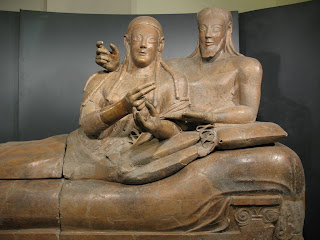Ancient Etruscan Sarcophagus of the Spouses, 520
BC, made of terracotta which was once brightly painted, currently
located at the Villa Giulia National Etruscan Museum, Rome.
From the Banditaccia necropolis in Caere (modern Cerveteri), previously owned by the Ruspoli family, from which Felice Barnabei, founder of the museum, bought broken into more than 400 fragments!
However, its function remains uncertain because burial and cremation
were both practiced by the Etruscans. It may actually have been a large
urn designed to contain the ashes of the deceased. Another example
similar to this work is known (Louvre, Paris).The urn is shaped as a bed upon which the deceased are resting and banqueting. The Etruscans, like the Greeks had adopted the Eastern custom of feasting in a reclining position. Etruscan women, who held an important place in society, could take part in a banquet (in Greece only men were admitted).


